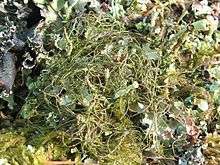Ammonia pollution
Ammonia pollution is pollution by the chemical ammonia (NH3) – a compound of nitrogen and hydrogen which is a byproduct of agriculture and industry. Common forms include air pollution by the ammonia gas emitted by rotting agricultural slurry and fertilizer factories while natural sources include the burning coal mines of Jharia, caustic Lake Natron and the guano of seabird colonies. Gaseous ammonia reacts with other pollutants in the air to form fine particles of ammonium salts which affect human breathing. Ammonia gas can also affect the soil chemistry of the locality that it settles on and will, for example, degrade the conditions required by the sphagnum moss and heathers of peatland.[1][2][3]
.jpg)
The distribution of particulates caused by ammonia pollution in the US

The lichen Bryoria fuscescens which is sensitive to ammonia pollution
References
- Van Damme, Martin; Clarisse, Lieven (5 December 2018), "Industrial and agricultural ammonia point sources exposed", Nature, 564 (7734): 99–103, doi:10.1038/s41586-018-0747-1, PMID 30518888
- Sutton, Mark A.; Howard, Clare M. (5 December 2018), "Satellite pinpoints ammonia sources globally", Nature, 564 (7734): 49–50, doi:10.1038/d41586-018-07584-7, PMID 30518893
- Mark Sutton; Stefan Reis; Samantha Baker, eds. (2008), Atmospheric Ammonia, Springer, ISBN 9781402091216
This article is issued from Wikipedia. The text is licensed under Creative Commons - Attribution - Sharealike. Additional terms may apply for the media files.